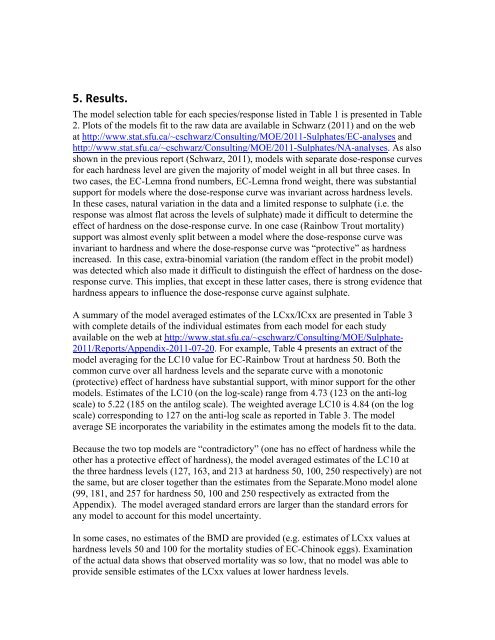Summary - People.stat.sfu.ca - Simon Fraser University
Summary - People.stat.sfu.ca - Simon Fraser University
Summary - People.stat.sfu.ca - Simon Fraser University
Create successful ePaper yourself
Turn your PDF publications into a flip-book with our unique Google optimized e-Paper software.
5. Results. The model selection table for each species/response listed in Table 1 is presented in Table2. Plots of the models fit to the raw data are available in Schwarz (2011) and on the webat http://www.<strong>stat</strong>.<strong>sfu</strong>.<strong>ca</strong>/~cschwarz/Consulting/MOE/2011-Sulphates/EC-analyses andhttp://www.<strong>stat</strong>.<strong>sfu</strong>.<strong>ca</strong>/~cschwarz/Consulting/MOE/2011-Sulphates/NA-analyses. As alsoshown in the previous report (Schwarz, 2011), models with separate dose-response curvesfor each hardness level are given the majority of model weight in all but three <strong>ca</strong>ses. Intwo <strong>ca</strong>ses, the EC-Lemna frond numbers, EC-Lemna frond weight, there was substantialsupport for models where the dose-response curve was invariant across hardness levels.In these <strong>ca</strong>ses, natural variation in the data and a limited response to sulphate (i.e. theresponse was almost flat across the levels of sulphate) made it difficult to determine theeffect of hardness on the dose-response curve. In one <strong>ca</strong>se (Rainbow Trout mortality)support was almost evenly split between a model where the dose-response curve wasinvariant to hardness and where the dose-response curve was “protective” as hardnessincreased. In this <strong>ca</strong>se, extra-binomial variation (the random effect in the probit model)was detected which also made it difficult to distinguish the effect of hardness on the doseresponsecurve. This implies, that except in these latter <strong>ca</strong>ses, there is strong evidence thathardness appears to influence the dose-response curve against sulphate.A summary of the model averaged estimates of the LCxx/ICxx are presented in Table 3with complete details of the individual estimates from each model for each studyavailable on the web at http://www.<strong>stat</strong>.<strong>sfu</strong>.<strong>ca</strong>/~cschwarz/Consulting/MOE/Sulphate-2011/Reports/Appendix-2011-07-20. For example, Table 4 presents an extract of themodel averaging for the LC10 value for EC-Rainbow Trout at hardness 50. Both thecommon curve over all hardness levels and the separate curve with a monotonic(protective) effect of hardness have substantial support, with minor support for the othermodels. Estimates of the LC10 (on the log-s<strong>ca</strong>le) range from 4.73 (123 on the anti-logs<strong>ca</strong>le) to 5.22 (185 on the antilog s<strong>ca</strong>le). The weighted average LC10 is 4.84 (on the logs<strong>ca</strong>le) corresponding to 127 on the anti-log s<strong>ca</strong>le as reported in Table 3. The modelaverage SE incorporates the variability in the estimates among the models fit to the data.Be<strong>ca</strong>use the two top models are “contradictory” (one has no effect of hardness while theother has a protective effect of hardness), the model averaged estimates of the LC10 atthe three hardness levels (127, 163, and 213 at hardness 50, 100, 250 respectively) are notthe same, but are closer together than the estimates from the Separate.Mono model alone(99, 181, and 257 for hardness 50, 100 and 250 respectively as extracted from theAppendix). The model averaged standard errors are larger than the standard errors forany model to account for this model uncertainty.In some <strong>ca</strong>ses, no estimates of the BMD are provided (e.g. estimates of LCxx values athardness levels 50 and 100 for the mortality studies of EC-Chinook eggs). Examinationof the actual data shows that observed mortality was so low, that no model was able toprovide sensible estimates of the LCxx values at lower hardness levels.
















